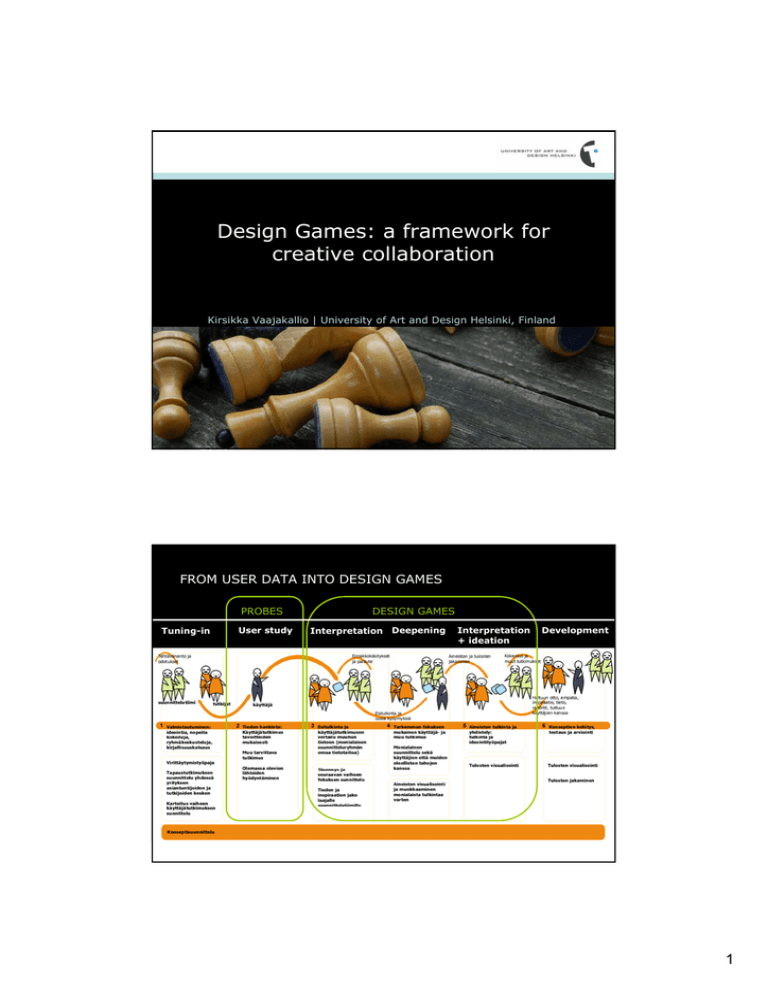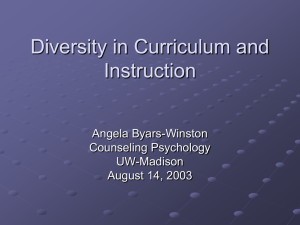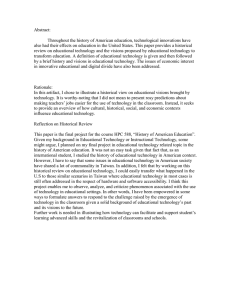Design Games: a framework for creative collaboration 1
advertisement

Design Games: a framework for creative collaboration Kirsikka Vaajakallio | University of Art and Design Helsinki, Finland FROM USER DATA INTO DESIGN GAMES PROBES Tuning-in User study DESIGN GAMES Interpretation Deepening Interpretation + ideation Development 1 DESIGN GAMES PROBES VIDEO CLIPS FROM THE OBSERVATIONS Game pieces PHOTOS FROM THE CONTEXT Game board QUOTES FROM THE INTERVIEWS Playing cards nt artme m ap “Drea balcony.” ha s a INTERPRETED USER DATA e.g. personas Rules Feasible shared visions & research agenda Feasible shared visions & research agenda … DESIGN GAMES in creative collaboration 1. To involve potential users, stakeholders and experts in design process. • Sharing knowledge. • Communicating user study. • Creating novel design solutions. >>> To develop better design solutions with the help of multidisciplinary group of actors. 2 What makes design a game? GAME METAPHOR IN DESIGN • Designing is a social process of achieving consensus among participants with different backgrounds and interests. • People look at the design task based on their expertise, experiences, responsibilities and personal concern about good design, and therefore designing requires negotiation between different understandings. SOCIAL ACTIVITY GAME PIECES ROLES RULES MANY PLAYERS FUN GOAL ORIENTED 3 GAME METAPHOR IN DESIGN • Designing is a social process of achieving consensus among participants with different backgrounds and interests. • People look at the design task based on their expertise, experiences, responsibilities and personal concern about good design, and therefore designing requires negotiation between different understandings. SOCIAL ACTIVITY Multidisciplinary Team work Plan Brief Objectives ROLES Workshop Use context GAME PIECES RULES Designer Facilitator Researcher User Producer MANY PLAYERS Mock-ups Make tools Videos Photos Interviews Acting out Exploring Learning Surprising FUN Solution System GOAL Service ORIENTED Product Knowledge DESIGN GAMES IN DESIGN 1. Organizational design games: to empower workers to envision future work situation in fun way (Ehn et al.). 2. Concept design games: to study architectural design processes and strategies (Habraken et al.). 4 DESIGN GAMES AS A FRAMEWORK FOR CREATIVE COLLABORATION 1. 2. 3. Setting the stage for collaborative design process Sharing / interpreting knowledge (e.g. user data) Generating new ideas Takes place in a workshop or use context. General design game characters: • Changing perspectives • Handling group dynamics • Providing things-to-think-with • Sparking dialogue • Grounding discussion • Binding “what is” and “what if” worlds • Building a shared design language What this means in practice? 5 FOCUS AND FACILITATE DISCUSSIONS FACILITATE GROUP DYNAMICS SPARK DIALOGUE EXPLORE AND SET THE STAGE FOR GENERATE COLLABORATIVE PROCESS IDEAS SHARE / INTERPRET USER DATA ETU Aim of the game: - Users as facilitators - Clarifying interpretations of user data with users - Getting new insights FOCUS AND FACILITATE DISCUSSIONS Aim of the project: to provide knowledge (user material) for designers and producers of daily products how to make packages easier to open and use. User group: rheumatoid arthritis (strength-impaired consumers) and everyone (DFA approach) 6 The game process Participatory Observations Interpretations Writing quotes on cards + Situated interviews Playing the game Modified interpretations Results: http://www.helppopakkausonetu.com/Tulokset/ETU_results_summary.pdf By next icon DESIGNING A UNIVERSITY: triggering discussion trough user data Aims: • Bring findings from the interviews into group discussions. • Facilitate group dynamics in order to support multidisciplinary team work. • Minimize status hierarchy. • Generate shared solutions / values of DF Game material: • Game board. • Quotes from the interviews written on the cards. • Well known characteristics as playful triggers for creativity. • Instruction cards (anyone in the group could act as a facilitator). Feasible Feasible shared shared visions visions & & research research agenda agenda “A “A linking linking point point of of research research & & practice/students” practice/students” “Experience “Experience 'hands-on' 'hands-on' work work with with tools” tools” 7 KIDS AS DESIGN PARTNERS: FACILITATING GROUP DYNAMICS Aims: • Enhancing creativity • Equal collaboration • Grounding current situation with future opportunities Setting: • Game rules • Game board • Game pieces • Scenario to be filled • Classroom setup • Make Tools 8 1. VIDEO OBSERVATION + IDEA GENERATION: SITUATED MAKE TOOLS ”Scenario oriented game” • Understanding current + envisioning future • Users as co-designers and experts • Design researcher provides support in co-design • Make tools enable imagining possible use situations Building make tools | Pilot session| briefing + building a dream device | situated idea generation “A PROCESS GAME” Aims: • Introducing a game approach • Building a common ground • Creating a project plan Setting: • Game rules • Method cards • Resource figures • Two hours • Workshop • 3 - 4 players Outcome: project plan for a case study 9 “A CHARACTER GAME” Aims: • Sharing knowledge • Interpreting user data • Design empathy • Design openings Inspired by: • Personas • Design games • Role playing Setting: • Game leader • Two hours • Workshop • Senior housing WHAT TO THINK IN DESIGN GAMES How to create an inspiring and engaging game? • Sensitivity towards design partners skills and attitudes is fundamental. • What is the design material? What is its main purpose? (enhance creativity, produce design suggestions, shared language,…) • What kind of rules support collaboration? (In particular context, design problem, goal and participating people, …) • Where and how long game will take? (is it one of many or only activity) • How to document the game playing? 10 WHAT TO THINK IN DESIGN GAMES How design games differ from workshops? • • • Explicit rules for collaboration Taking turns Utilizing a game board and game material SUMMARY: DESIGN GAMES IN CREATIVE COLLABORATION SETTING THE STAGE INTERPRET GENERATE DEVELOP Reason Plan and facilitate codesign project Share user data, engage stakeholders, design openings Generate ideas / concepts, engage stakeholders and potential users Test and develop concepts / ideas, engage various people (e.g. users) Focus Expectations, resources, opportunities Current situation, empathy, cointerpretation Future opportunities, creativity Value evaluation, prototyping, (Business view) Material Methods cards, process titles, resource figures Field data transformed into a game Things-to-thinkwith, user descriptions etc. Prototypes, scenarios / stories, props for enacting Rules Negotiation, equal collaboration New perspectives, New perspectives, dialogue Creative constrains New perspectives, Creative constrains Site Room with big table Workshop setting Workshop / contextual setting Workshop / contextual setting Players Project team and managers Design team and stakeholders Design team, stakeholders, users Design team, stakeholders, users Empathy, insights from user study, themes for focus Ideas, Proposals for concepts Concepts Outcome Initial project plan 11 Thank you! Questions? 12



